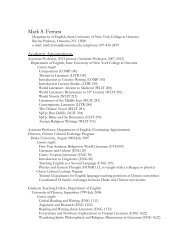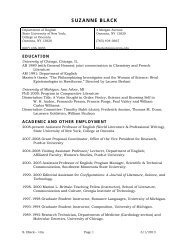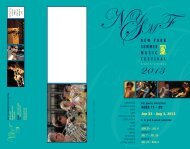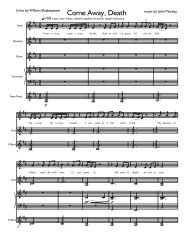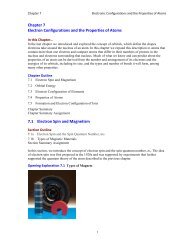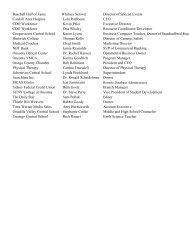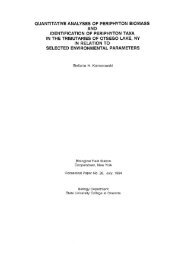Water Chestnut (Trapa natans L.) Infestation in the ... - SUNY Oneonta
Water Chestnut (Trapa natans L.) Infestation in the ... - SUNY Oneonta
Water Chestnut (Trapa natans L.) Infestation in the ... - SUNY Oneonta
You also want an ePaper? Increase the reach of your titles
YUMPU automatically turns print PDFs into web optimized ePapers that Google loves.
Yet ano<strong>the</strong>r effect of <strong>Trapa</strong> on ecosystem processes is <strong>in</strong> <strong>the</strong> area of <strong>in</strong>vertebrate<br />
communities. As mentioned before, water chestnut leaves release oxygen <strong>in</strong>to <strong>the</strong><br />
atmosphere while <strong>the</strong> stems and roots consume oxygen from <strong>the</strong> water, so beneath <strong>the</strong><br />
large, dense beds <strong>the</strong> water may become hypoxic or even anoxic. Because <strong>Trapa</strong> has a<br />
different architecture than submerged plants, and depletes water of dissolved oxygen, it<br />
has been thought to support dist<strong>in</strong>ctive communities of macro<strong>in</strong>vertebrates and fish<br />
(Strayer et al. 2003).<br />
Impacts on Humans<br />
The impacts of a water chestnut <strong>in</strong>vasion are not only devastat<strong>in</strong>g ecologically,<br />
but also negatively affect humans. In most areas <strong>the</strong> biggest problem has become <strong>the</strong><br />
<strong>in</strong>terference of water chestnut <strong>in</strong> recreational and economic uses of navigable waters.<br />
Dense mat and root systems can completely cover <strong>the</strong> surface of <strong>the</strong> water, prevent<strong>in</strong>g<br />
swimm<strong>in</strong>g and canoe<strong>in</strong>g and tangl<strong>in</strong>g <strong>in</strong> propellers of motor boats. In addition, <strong>the</strong> sp<strong>in</strong>y<br />
seeds of <strong>the</strong> chestnut have been known to cause harmful <strong>in</strong>jury to ba<strong>the</strong>rs and beach<br />
users. Similarly to <strong>in</strong>festations of Eurasian water milfoil (Myriophyllum spicatum), <strong>the</strong><br />
mats are favorable sites for mosquito breed<strong>in</strong>g. <strong>Water</strong> chestnut also affects <strong>the</strong> aes<strong>the</strong>tic<br />
value of an area. The plant is likely to be regarded as unattractive <strong>in</strong> large quantities and<br />
can be unsightly when washed ashore. Recreational fish<strong>in</strong>g is also affected as many fish<br />
populations tend to avoid <strong>the</strong> <strong>in</strong>fested areas because normal biological processes are<br />
term<strong>in</strong>ated or severely reduced (NEMESIS 2005)<br />
Economically, efforts to reduce plant population sizes and stop its spread<strong>in</strong>g have<br />
been costly. In <strong>the</strong> Chesapeake Bay region alone, $2.8 million have been spent <strong>in</strong> <strong>the</strong> past<br />
20 years for mechanical harvest<strong>in</strong>g, herbicide applications and hand pull<strong>in</strong>g and<br />
monitor<strong>in</strong>g programs (NEMESIS 2005).<br />
Because of <strong>the</strong> nuisance of water chestnut and o<strong>the</strong>r aquatic <strong>in</strong>vasives, more<br />
precautions are be<strong>in</strong>g taken and more legislation is be<strong>in</strong>g created to address <strong>the</strong>se<br />
concerns. For example, many states have created strict legislation to require permits for<br />
all water withdrawals and water transports to prevent <strong>the</strong> spread of any <strong>in</strong>vasive plants,<br />
<strong>in</strong>clud<strong>in</strong>g New York. Bulk water transporters that offer such services as fill<strong>in</strong>g swimm<strong>in</strong>g<br />
pools, hydroseed<strong>in</strong>g, irrigation, spray<strong>in</strong>g for dust control and roadbed compaction at<br />
construction sites, and similar activities often withdraw water from rivers or lakes at<br />
convenient access po<strong>in</strong>ts. Many states now require pipes, hoses and tanks of trucks to be<br />
<strong>in</strong>spected and thoroughly cleaned (Mills et al. 1996).<br />
Invasion of Chesapeake Bay <strong>Water</strong>shed<br />
A dist<strong>in</strong>ct feature, and one of <strong>the</strong> Chesapeake Bay’s vital natural resources, is <strong>the</strong><br />
beds of submerged aquatic plants that <strong>in</strong>habit <strong>the</strong> shallow water areas. In addition to its<br />
high primary productivity, this vegetation is significant because it is a food source for<br />
waterfowl, a habitat and nursery for many species, a shorel<strong>in</strong>e erosion control system and<br />
a nutrient buffer. However, over <strong>the</strong> past 50 years, <strong>the</strong>re have been several dist<strong>in</strong>ct<br />
periods <strong>in</strong> which significant changes occurred with<strong>in</strong> <strong>the</strong> submergent aquatic vegetation.<br />
These ecological changes began with <strong>the</strong> Zostera mar<strong>in</strong>a wast<strong>in</strong>g disease <strong>in</strong> <strong>the</strong> 1930s<br />
11



